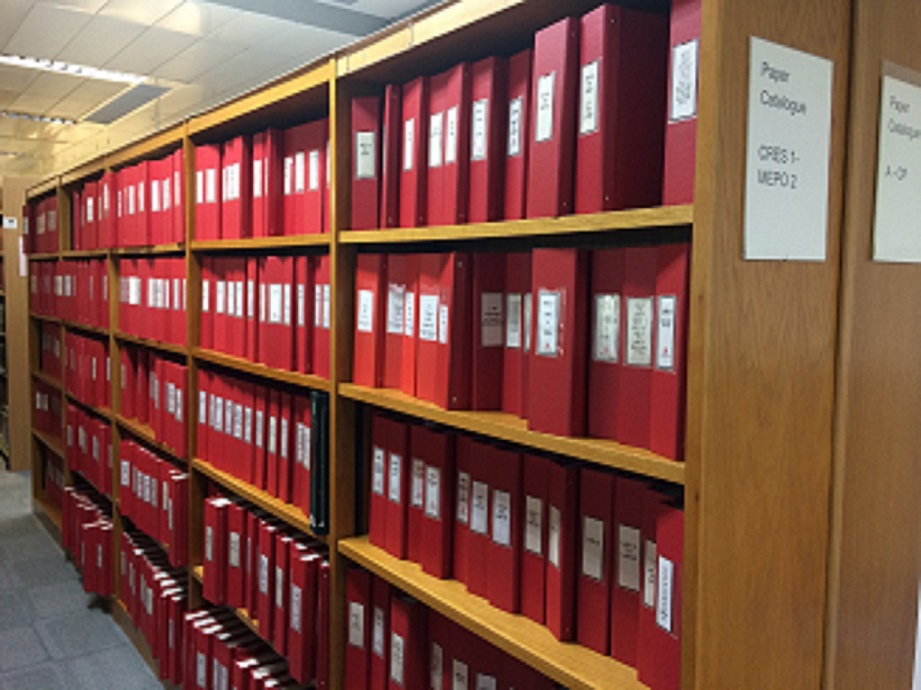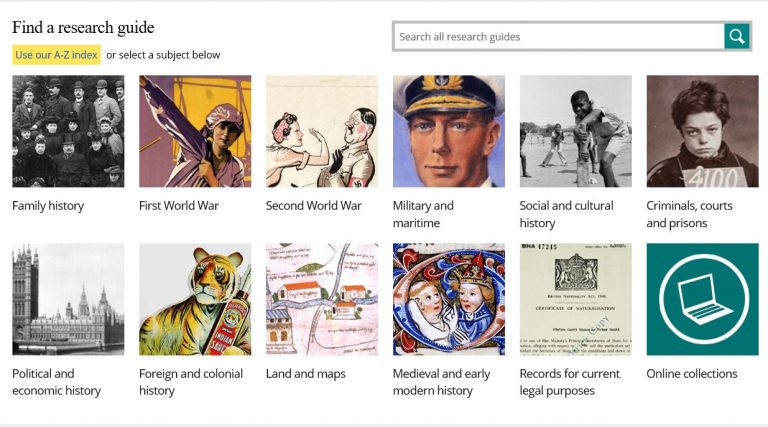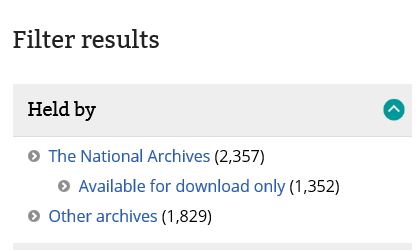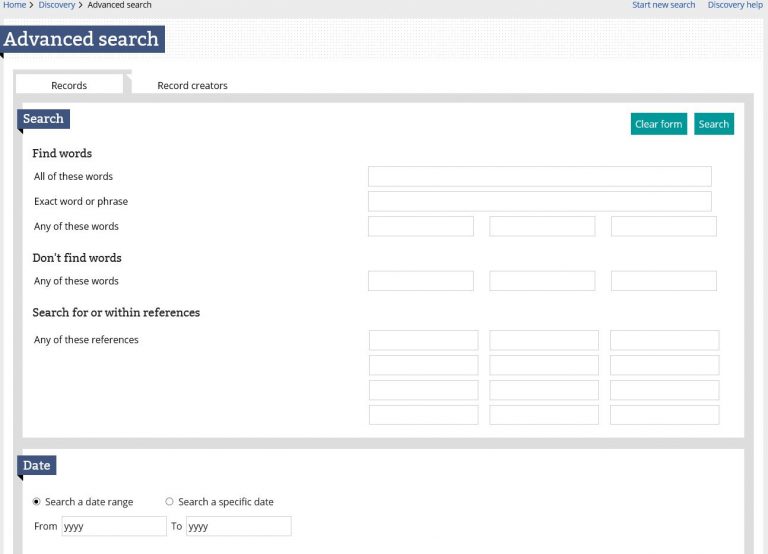Discovery – friend or foe?
Catalogues are essential tools for anyone wanting to explore archives. Working at The National Archives, though, you quickly realise that many first-time (and some more experienced) researchers initially see them as something of an obstacle.
- ‘Why is your catalogue so complicated?’
- ‘I just want to find my uncle’s service record’
- ‘I searched your catalogue but got a load of stuff I don’t understand’
Discovery, The National Archives’ catalogue, was launched back in April 2011. It replaced our first online catalogue, which had in turn been created to replace an original paper catalogue. The paper catalogue used to fill many shelves, but now only a few parts of it are left in the Research Enquiries Room at Kew. These are kept because, in some cases, paper is easier to browse through; but in most cases the best way to find records is by using Discovery.

The paper catalogue
These days, Discovery is not just a catalogue of records held at The National Archives: it also incorporates catalogues from 2500 other archives, most of which are in the UK but some of which are abroad. Altogether, it contains over 32 million descriptions of records.
There’s no getting away from the fact that its sheer size can make Discovery a complicated beast to get to know. If you dive into it without understanding how to use it, you can find yourself frustrated and confused – hence the feedback we sometimes get that Discovery is rubbish, confusing or ‘sending me round in circles’. But with a little patience you can grow to appreciate it and make it work for you. The key things to understand are:
- How an archive works
- What document references are
- How to choose the right search terms
- How to understand your search results
How an archive works
In an archive, records are arranged according to the organisation that created them. Our records come from central government departments and the major courts of law, going back almost 1,000 years to Domesday Book. All the records from each department are kept together and we don’t mix them up even if they deal with the same subject.
If you are researching somebody who was in England or Wales for the 1911 census, served in the First World War and then was a passenger on a ship in 1928 you won’t find everything in one place; instead, you will find records for these events in collections from three different government departments (Registrar General, War Office and Board of Trade respectively).
Each department had its own way of organising its records and that can mean you need to have a range of search techniques. These are explained in our many research guides that deal with over 340 different research areas. See my previous post ‘Where do I start my research’ for more information on research guides.

Research guide categories
Understanding document references
The references for the records in The National Archives’ collection have multiple parts – and it’s really helpful to understand what these are. Starting at the highest level, you have a letter code which is shared by all records from a particular government department. For example, all records from the War Office start with WO, and all records from the Cabinet Office start with CAB.
After the letter code, document references have a ‘series’ number. If a government department created a lot of records there will be more series numbers. For example, there are 57 series for the Forestry Commission (letter code F), but there are 1,113 series for the Foreign Office (letter code FO). Within each series there are a number of ‘pieces’, which are also given a number. Sometimes pieces are further divided into ‘items’.
Here are some examples of document references – they all have a letter code, series and piece number, and the first three also have an item number. You can click on the link to read the document description for each reference.
For a further exploration of why and how archivists use record series, see Andrew Janes’ blog post ‘A series of unfortunate events‘.
How to choose the right search terms
The descriptions of documents held here at The National Archives were usually written by the people who created or worked with them. Sometimes these descriptions are sparse; other times they are more helpful. It’s the descriptions that make up the catalogue, so if you search for words that aren’t in the description then you won’t find anything.
If you’re looking for a particular person, his or her name might be in a document somewhere – but if it’s not in the catalogue description then searching for their name won’t find them. Instead, you need to think about what sort of record you think they might be mentioned in and then think about how that might have been described.
Sometimes you need to put aside your own specific question and start by thinking about who might have created the information you’re looking for and why. What might they have needed it for? Why might they have kept it? This might help you to work out how they might have described it.
For more helpful advice on ways to locate and identify interesting records see Andrew Janes’ blog post ‘The boy who found the horse‘.
How to understand your search results
A list of search results can include records in different formats held in a variety of archives. Remember that you will be looking at descriptions of records rather than their content. Here are some of the things that might appear in your list of search results:
Full record series held at The National Archives such as
- WO 95 – First World War regimental war diaries from the War Office
- FO 371 – General correspondence from the Foreign Office
Individual records held at The National Archives such as
- BT/28/244202 – registered design by Thomas and James Middleton from Smethwick
- RAIL 806/21 – a journal from the Barnsley Canal Company
Records held in other archives such as
- BDB 19 – a wages book from Spark Bridge Bobbin Mill held at Cumbria Archive and Local Studies Centre
- 103/Z1 – a printed, coloured engraving of the West Riding by John Speede held at Sheffield City Archives
Records that can be viewed on our partner websites such as
- RG 13/5251 – 1901 census returns for Bala, Merionethshire
- WO 363/K49 – First World War service records for Kemp, Walter to Kemp William
Records that can be downloaded from Discovery such as
- BT 389/2/196 – Second World War merchant shipping movement card for the SS Athenia
- MPF 1/68 – map of Hibernia drawn by John Goghe in 1567
Records that are retained by the department that created them, or where the contents are closed to the public such as
- WO 409/27/61/170 – Home Guard record for Durham 18th battalion
- FCO 141/10330 – Representation of Maltese population at the coronation of HM Queen Elizabeth
Your search results list will appear in order of relevance – but you can re-order it by reference, title or date using the dropdown menu at the top of the list. To find out more about any of your search results, click on the title to see the full description. Look at the hierarchy (‘You are in…’) shown above the description to understand the context of the record.
Other top tips for using Discovery
If you’re the type of person that likes to have a go at something rather than read instructions, that’s fine. You can try searching Discovery straight off using the main search box here, or you can use the advanced search option here.
Using the Discovery main search box

Discovery main search box
Using the main search might bring you a lot of results, but you can use the filters on the left of your results to get rid of ones that aren’t relevant.
First, look at where it says ‘Held by’ – sometimes it’s interesting just to note that a certain number of your results are at The National Archives and others are at other archives. If the number at other archives is significant, it might be that those are the best ones to start with.

Choose from records held by The National Archives or other archives
If you click on either Held by The National Archives or Held by other archives you will see that other filtering options open up.
For records held at The National Archives, you will be able to see which government departments created the records in your search results and how many fall into each department. For records held at other archives, you will be able to see which archives they are.
Again, if you choose Held by The National Archives you will also be able to use filters based on subjects, catalogue level, closure status and record opening date.
Using Discovery advanced search

Discovery advanced search
If you use the advanced search option, you can restrict your search by date and by department code or record series. The research guides will advise you on the best record series to search within for your research area.
If you choose Held by The National Archives on the advanced search page, then a number of other filtering options will open up. One of these is Taxonomy subjects, and you can use this to restrict your search to specific subject areas.
Discovery help
If you are still struggling, there’s a lot more advice in the Discovery help pages which you can find at the top of pages in Discovery.
This all sounds fine, but some of the more recent entries are rubbish (one document sent in by MOD dated 1783-1820 referring to documents in the Public Record Office (which wasn’t created let alone built until 1838) and the Taxonomy subjects don’t work (e.g. Dollar Drain – about lack of Dollar currencies in the UK is listed under Sewerage) and a lot of COPY 1 files listed as “Sterlingshire”, it is of course “Stirlingshire”, there is a need to get away from describing documents as seen to making them findable (see the old Editorial Standard on Names). BT 377/7/ is an example of poor editorial plans, documents that are descripted wrongly at the time and cases where what is in Discovery bears no resemblance to what is on the page (e.g. Great Yarmouth, Devon – it actually says Plymouth, Devon). The description terms may not be the same as today and may even feel offensive. Last and not least TNA is not ‘The National Archives of the UK’ as people may think and there are national archives in Scotland and Ireland (in Dublin and Belfast).
It’s a shame that Mr Matthew has found nothing positive at all to say. I notice from comments he has made on other blogs that he very rarely has. Perhaps he should find an institution more to his liking – he might be happier there. Thank you Sarah for a helpful blog.
Thanks for a very useful introduction, you are absolutely right about getting into the head of the person creating the record when it comes to thinking of search queries.
My top tip would be to put the search term into double quotes, such as “Horatio Nelson”, as this can really cut down the number of results.